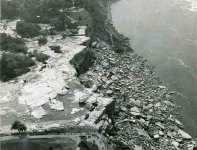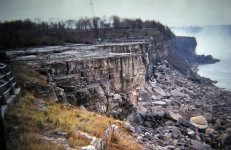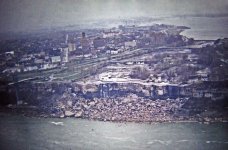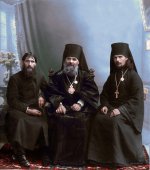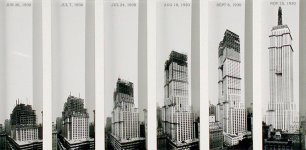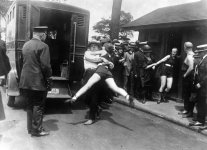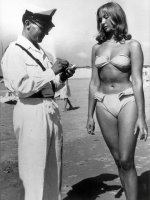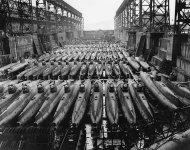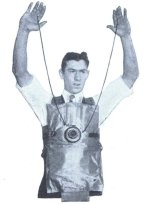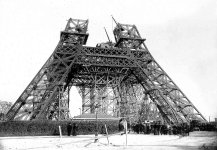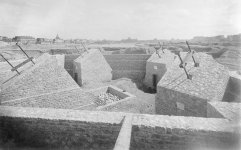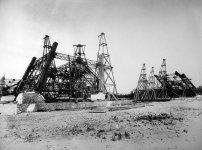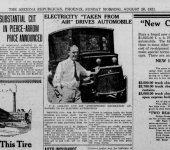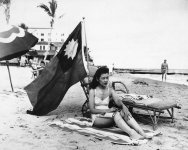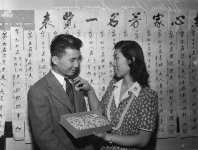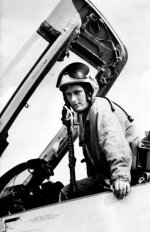Install the app
How to install the app on iOS
Follow along with the video below to see how to install our site as a web app on your home screen.
Note: This feature currently requires accessing the site using the built-in Safari browser.
You are using an out of date browser. It may not display this or other websites correctly.
You should upgrade or use an alternative browser.
You should upgrade or use an alternative browser.
Blast from the past
- Thread starter Administrator
- Start date
Niagara Falls without water, 1969
For six months in the summer and fall of 1969, Niagara?s American Falls were ?de-watered?, as the Army Corps of Engineers conducted a geological survey of the falls? rock face, concerned that it was becoming destabilized by erosion. These stark images reveal North America?s iconic ? and most powerful ? waterfall to be almost as dry as a desert.
Niagara Falls is the collective name for three waterfalls that straddle the international border between Canada and the United States. From largest to smallest, the three waterfalls are the Horseshoe Falls, the American Falls and the Bridal Veil Falls.
The Horseshoe Falls lie mostly on the Canadian side and the American Falls entirely on the American side, separated by Goat Island. The smaller Bridal Veil Falls are also on the American side, separated from the other waterfalls by Luna Island.
To dewater the Niagara?s American Falls the army had to build a 600ft (182 m) dam across the Niagara River, which meant that 60,000 gallons of water that flowed every second was diverted over the larger Horseshoe Falls which flow entirely on the Canadian side of the border.
The dam itself consisted of 27,800 tons of rock, and on June 12, 1969, after flowing continuously for over 12,000 years, the American Falls stopped. The completed dewatering of the American Falls was made easier because only 10% of the water follows that route.
While the Horseshoe Falls absorbed the extra flow, the U.S. Army Corps of Engineers studied the riverbed and mechanically bolted and strengthened any faults they found; faults that would, if left untreated, have hastened the retreat of the American Falls. A plan to remove the huge mound of talus deposited in 1954 was abandoned because of the high cost.
For a portion of that period, while workers cleaned the former river-bottom of unwanted mosses and drilled test-cores in search of instabilities, a temporary walkway was installed a mere twenty feet from the edge of the dry falls, and tourists were able to explore this otherwise inaccessible and hostile landscape.
Finally, in November 1969 in front of 2,650 onlookers, the temporary dam was dynamited, restoring flow to the American Falls.
Even after these undertakings, Luna Island, the small piece of land between the main waterfall and the Bridal Veil, remained off-limits to the public for years owing to fears that it was unstable and could collapse into the gorge.
For six months in the summer and fall of 1969, Niagara?s American Falls were ?de-watered?, as the Army Corps of Engineers conducted a geological survey of the falls? rock face, concerned that it was becoming destabilized by erosion. These stark images reveal North America?s iconic ? and most powerful ? waterfall to be almost as dry as a desert.
Niagara Falls is the collective name for three waterfalls that straddle the international border between Canada and the United States. From largest to smallest, the three waterfalls are the Horseshoe Falls, the American Falls and the Bridal Veil Falls.
The Horseshoe Falls lie mostly on the Canadian side and the American Falls entirely on the American side, separated by Goat Island. The smaller Bridal Veil Falls are also on the American side, separated from the other waterfalls by Luna Island.
To dewater the Niagara?s American Falls the army had to build a 600ft (182 m) dam across the Niagara River, which meant that 60,000 gallons of water that flowed every second was diverted over the larger Horseshoe Falls which flow entirely on the Canadian side of the border.
The dam itself consisted of 27,800 tons of rock, and on June 12, 1969, after flowing continuously for over 12,000 years, the American Falls stopped. The completed dewatering of the American Falls was made easier because only 10% of the water follows that route.
While the Horseshoe Falls absorbed the extra flow, the U.S. Army Corps of Engineers studied the riverbed and mechanically bolted and strengthened any faults they found; faults that would, if left untreated, have hastened the retreat of the American Falls. A plan to remove the huge mound of talus deposited in 1954 was abandoned because of the high cost.
For a portion of that period, while workers cleaned the former river-bottom of unwanted mosses and drilled test-cores in search of instabilities, a temporary walkway was installed a mere twenty feet from the edge of the dry falls, and tourists were able to explore this otherwise inaccessible and hostile landscape.
Finally, in November 1969 in front of 2,650 onlookers, the temporary dam was dynamited, restoring flow to the American Falls.
Even after these undertakings, Luna Island, the small piece of land between the main waterfall and the Bridal Veil, remained off-limits to the public for years owing to fears that it was unstable and could collapse into the gorge.
Attachments
Grigori Rasputin, Bishop Hermogenes and Hieromonk Iliodor in Tsaritsyn, 1906
Rasputin, Hermogen and Iliodor next to each other in 1906. Within a few years the three men became bitter enemies.
Grigori Yefimovich Rasputin was a Russian peasant, mystical faith healer, and trusted friend of the family of Nicholas II, the last Tsar of Russia. He became an influential figure in Saint Petersburg, especially after August 1915, when Nicholas took command of the army fighting in World War I.
Hermogenes was a prominent Russian Orthodox religious figure and a monarchist with extreme right ideas, supporting the Union of the Russian People and Black Hundreds. In 1917, he was appointed as Hermogenes, Bishop of Tobolsk and Siberia.
Hieromonk Iliodor (Sergei Trufanov) was a lapsed hieromonk, a charismatic churchman, an enfant terrible of the Orthodox church, and panslavist. He is known primarily for his book, semi-autobiographical, and biographical on Rasputin.
In this work, he was supported by Maxim Gorky, who hoped that Trufanoff?s story on Rasputin would discredit the Tsar?s family and eventually contribute to the revolutionary propaganda.
In December 1911, Hermogenes and Iliodor came into conflict with Rasputin, who had almost free access to the Imperial family. Hermogen started rumors that Rasputin had joined the Khlysty, an obscure Christian sect with strong Siberian roots.
After having been beaten by Hermogen with a crucifix, in a monastery on Vasilyevsky Island, Rasputin complained to the Imperial couple. Within a few weeks, Empress of Russia Alexandra ordered Hermogenes to be banished to a monastery.
In Summer 1914, after an attack on Rasputin by Khioniya Kozmishna Guseva, Iliodor Iliodor went into exil. Rasputin believed Iliodor and Vladimir Dzhunkovsky had organized the attack.
Gusseva, a fanatically religious woman, had been his adherent in earlier years and ?denied Iliodor?s participation, declaring that she attempted to kill Rasputin because he was spreading temptation among the innocent?.
Rasputin, Hermogen and Iliodor next to each other in 1906. Within a few years the three men became bitter enemies.
Grigori Yefimovich Rasputin was a Russian peasant, mystical faith healer, and trusted friend of the family of Nicholas II, the last Tsar of Russia. He became an influential figure in Saint Petersburg, especially after August 1915, when Nicholas took command of the army fighting in World War I.
Hermogenes was a prominent Russian Orthodox religious figure and a monarchist with extreme right ideas, supporting the Union of the Russian People and Black Hundreds. In 1917, he was appointed as Hermogenes, Bishop of Tobolsk and Siberia.
Hieromonk Iliodor (Sergei Trufanov) was a lapsed hieromonk, a charismatic churchman, an enfant terrible of the Orthodox church, and panslavist. He is known primarily for his book, semi-autobiographical, and biographical on Rasputin.
In this work, he was supported by Maxim Gorky, who hoped that Trufanoff?s story on Rasputin would discredit the Tsar?s family and eventually contribute to the revolutionary propaganda.
In December 1911, Hermogenes and Iliodor came into conflict with Rasputin, who had almost free access to the Imperial family. Hermogen started rumors that Rasputin had joined the Khlysty, an obscure Christian sect with strong Siberian roots.
After having been beaten by Hermogen with a crucifix, in a monastery on Vasilyevsky Island, Rasputin complained to the Imperial couple. Within a few weeks, Empress of Russia Alexandra ordered Hermogenes to be banished to a monastery.
In Summer 1914, after an attack on Rasputin by Khioniya Kozmishna Guseva, Iliodor Iliodor went into exil. Rasputin believed Iliodor and Vladimir Dzhunkovsky had organized the attack.
Gusseva, a fanatically religious woman, had been his adherent in earlier years and ?denied Iliodor?s participation, declaring that she attempted to kill Rasputin because he was spreading temptation among the innocent?.
Attachments
In a drydock at Kure Naval Base, Japan, 19 October 1945. There are at least four different types of midget submarines in this group of about eighty-four boats, though the great majority are of the standard ?Koryu? type. The two boats at right in the second row appear to have an enlarged conning tower and shortened hull superstructure. The two boats at left in that row are of the earlier Type A or Type C design, as are a few others further back in the group.
Attachments
This specialized self-defense device appeared in a 1929 issue of Modern Mechanix. Samuel Schwarz designed it so that when the user raises his hands, he pulls strings attached to his fingers and activates a machine gun built into an armored vest.
Attachments
Beauty pageants (a mainstay in Western culture, particularly America) were banned in the Soviet Union since 1959 ? no scantily clad ladies, no cheeky fashion, no celebration of beauty and poise.
However, the landscape changed in 1985 with the appointment of Mikhail Gorbachev who became the youngest General Secretary of the Communist Party.
His appointment ushered in a new era of social freedom for the citizens of the USSR ? including the removal of the ban on beauty pageants.
Three years later the first official USSR beauty contest ?Moscow Beauty 1988? was held in the Luzhniki Palace of Sports in Soviet Moscow and became a real sensation for the world community.
However, the landscape changed in 1985 with the appointment of Mikhail Gorbachev who became the youngest General Secretary of the Communist Party.
His appointment ushered in a new era of social freedom for the citizens of the USSR ? including the removal of the ban on beauty pageants.
Three years later the first official USSR beauty contest ?Moscow Beauty 1988? was held in the Luzhniki Palace of Sports in Soviet Moscow and became a real sensation for the world community.
Attachments
ozcopper said:Chinese Americans labeling themselves to avoid being confused with the hated Japanese Americans, 1941
A bit of history on the Chinese flag.
https://youtu.be/Ac0Uk-I2RYU
MiG-21 crashed into an East German apartment block, 1975
On January 14th, 1975, Major Peter Makowicka, aged 33, was on a training mission with his Mikoyan-Gurevich MiG 21 plane. During approach on the military airbase Cottbus, German Democratic Republic (Eastern Germany), the plane experienced an open cover latch on the engine compressor section, which had been insufficiently secured by a maintenance technician. The engine switched off.
Immediately after the distress, the military control center ordered the pilot to deploy the ejection seat to save himself and to let the plane go down.
But Major Makowicka disobeyed, instead he pulled up to prevent the plane from crashing into the TKC (Textile Combinate Cottbus) with its thousands of workers, intending to let the plane crash into an empty field instead.
There was no time to get that far away. In the residential area behind the factory site, the aircraft grazed the roof of a building and at 10.15 am pierced a ?Plattenbau? (a 5-story large-panel system building) across the street. Mackovicka and five women were killed on the spot.
The plane had hit the second floor of the apartment block. The fire had spread from the basement to the 4th floor. It was unknown whether the plane carried ammo.
However, the fire chief correctly deduced acute danger from explosions. It was decided to attack the fire from the street side and to evacuate the other entries. The decisions later prove to be right.
The firefighters discovered that the plane still carried more than 800 liters of fuel. Upon impact, all four tanks had ruptured and the entire fuel escaped instantaneously, explaining the intensive burn and multiple, deflagration-like flare-ups on the 1st to 4th floors.
One hour and 15 minutes after the crash, the fire was, by and large, extinguished. All in all, 200-300 firefighters, police, medics, and NVA soldiers were on the scene. Sixteen residents suffered severe injuries, many had jumped out of the windows in panic. One woman died in hospital, raising the death toll of the accident to 7.
The area was sealed off hermetically. Two days later, only a patch in the wall remained as evidence for what happened. The official news agency ADN reported only that a plane crashed, killing six people ? and that an official commission has been tasked with the investigation.
The technician who failed to close the latch properly was sentenced to five years in jail. Major Peter Makowicka, likely the only NVA (National People?s Army) hero ever to disobey an order, posthumously received the Kampforden f?r Verdienste um Volk und Vaterland in Gold (Combat medal for the merits for the People and Fatherland) and other awards.
On January 14th, 1975, Major Peter Makowicka, aged 33, was on a training mission with his Mikoyan-Gurevich MiG 21 plane. During approach on the military airbase Cottbus, German Democratic Republic (Eastern Germany), the plane experienced an open cover latch on the engine compressor section, which had been insufficiently secured by a maintenance technician. The engine switched off.
Immediately after the distress, the military control center ordered the pilot to deploy the ejection seat to save himself and to let the plane go down.
But Major Makowicka disobeyed, instead he pulled up to prevent the plane from crashing into the TKC (Textile Combinate Cottbus) with its thousands of workers, intending to let the plane crash into an empty field instead.
There was no time to get that far away. In the residential area behind the factory site, the aircraft grazed the roof of a building and at 10.15 am pierced a ?Plattenbau? (a 5-story large-panel system building) across the street. Mackovicka and five women were killed on the spot.
The plane had hit the second floor of the apartment block. The fire had spread from the basement to the 4th floor. It was unknown whether the plane carried ammo.
However, the fire chief correctly deduced acute danger from explosions. It was decided to attack the fire from the street side and to evacuate the other entries. The decisions later prove to be right.
The firefighters discovered that the plane still carried more than 800 liters of fuel. Upon impact, all four tanks had ruptured and the entire fuel escaped instantaneously, explaining the intensive burn and multiple, deflagration-like flare-ups on the 1st to 4th floors.
One hour and 15 minutes after the crash, the fire was, by and large, extinguished. All in all, 200-300 firefighters, police, medics, and NVA soldiers were on the scene. Sixteen residents suffered severe injuries, many had jumped out of the windows in panic. One woman died in hospital, raising the death toll of the accident to 7.
The area was sealed off hermetically. Two days later, only a patch in the wall remained as evidence for what happened. The official news agency ADN reported only that a plane crashed, killing six people ? and that an official commission has been tasked with the investigation.
The technician who failed to close the latch properly was sentenced to five years in jail. Major Peter Makowicka, likely the only NVA (National People?s Army) hero ever to disobey an order, posthumously received the Kampforden f?r Verdienste um Volk und Vaterland in Gold (Combat medal for the merits for the People and Fatherland) and other awards.






